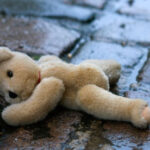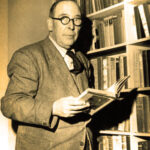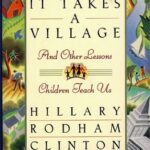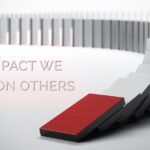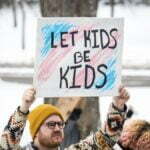The War Against Our Children
“It is children’s right to be children, to enjoy the pleasures of a childhood. . . . In the end, a childhood is the most basic human right of children.” So wrote David Elkind in his important 1981 book, The Hurried Child: Growing Up Too Fast Too Soon. Yet modern society seems to be doing its best to rob children of their childhood.
Elkind continues: “Hurried children are forced to take on the physical, psychological, and social trappings of adulthood before they are prepared to deal with them. We dress our children in miniature adult costumes (often with designer labels), we expose them to gratuitous sex and violence, and we expect them to cope with an increasingly bewildering social environment – divorce, single parenthood, homosexuality. Through all of these pressures the child senses that it is important for him or her to cope without admitting the confusion and pain that accompany such changes. Like adults, they are made to feel they must be survivors, and surviving means adjusting – even if the survivor is only four or six or eight years old.”
The signs of such an anti-child environment are everywhere. Our schools serve up large doses of scary scenarios about environmental doom and gloom, AIDS awareness, suicide education, etc. The news media dish out a steady diet of tragic and gruesome stories. In a recent newspaper there was a front page story of a 14-year-old boy who died of a heroin overdose. A 14-year-old boy! Another article reports that 14-year olds are making $300 a day by selling heroin. In another story we learn of free heroin samples being given away to entice young people. One nationwide poll found that 36 per cent of 14 to 24-year-olds admitted they had their first alcoholic drink at 14 or younger.
Drugs and alcohol are not the only killers of our young people. A recent article entitled “Our daughters are dying” spoke of young girls dying of anorexia in an attempt to obtain the perfect body. Some teenage girls force themselves to vomit in the desire to match the waif-like models of Cleo and Cosmo. Eight-year-old girls are dieting to starvation in their desires to grow up to be supermodels.
Children are increasingly being exposed to sexually explicit material at younger and younger ages, material which many of their parents would never have seen in a lifetime. Indeed, one sex therapist said recently that life is becoming like a peepshow for children. Many young children are acting out on other children the sexual behaviour they see on television, warned the therapist. Indeed, the job of parents to protect their children from gratuitous sex and violence grows harder, with everything from sleazy magazines in milk bars to pornography on the internet making it readily available.
Schools are no longer the safe places they once used to be for children. One recent headline, “School Weapons Blitz,” spoke of plans to offer students CDs and sports goods in exchange for their knives and machetes in Melbourne’s western suburbs. Another recent headline spoke of children turning to violence at ever younger ages, with many 4 to 6 year olds becoming increasingly violent to classmates – physically and verbally.
Problems once seen as exclusive to adult experience are now the domain of children. One news story spoke of “classroom mums” and the problems of schools having to deal with pregnant secondary school students. Another recent headline spoke of youth gangs becoming major problems in our big cities. Other headlines speak of binge drinking resulting in blackouts for a third of all 13 and 14 year olds; of 100,000 teenagers taking up smoking each year; of one in four year 11 girls considering suicide; and of one in ten teens calling for advice on Kids Help Line. Added to all this, of course, are the constant stream of news stories about child sexual abuse, including paedophile attacks on small children.
Other indicators could be mentioned. Numerous surveys have found that today’s young people lack a sense of purpose and meaning, and many have a very bleak outlook on life in general. One survey found that many respondents experienced “a strong sense of negativity, helplessness, despondency and even anguish”. Furthermore, employers reported to a federal inquiry recently that most youth lack basic skills, and many young job seekers could not read or write well. Another article notes that one-third of 15-year-olds have no basic literacy skills.
An example closer to my own home concerns the popular Goosebumps books for young people. I was alarmed to learn that our first grader is watching the Goosebumps videos with his classmates in primary school. It’s one thing to allow more mature children to choose to read a Goosebumps book, but quite another to compel a class of 6-year-olds to watch a graphic video, containing horror, violence and occult themes, which even many adults might find scary.
Why are children losing their childhood? There are perhaps many reasons, but some would have to include the deliberate exploitation of children by non-children. Advertisers for example, have recently discovered how lucrative the child market is. One study found that the consumer influence of children is worth $52 billion a year. Because kids watch a lot more TV than their parents, they become a prime target of marketing campaigns. Another study found that 10 to 17-years-olds are the ideal consumers, with an average disposable weekly income of $37 a week.
The heavy demands being placed on our children by Western consumerism are ironically being offset by the same materialistic culture. Affluent Western culture has made it possible for our children – indeed, all of us – to live longer, healthier and more prosperous lives than at any other time. Yet with our material abundance has come a stagnation of soul and spirit.
Social scientist Richard Eckersley has studied the attitudes of children and teenagers for over a decade. He believes that behind the growing trends of youth homelessness, youth suicide, drug abuse and other problems lies a “failure to provide a sense of meaning, belonging and purpose in our lives, and a framework of values.” He notes that many young people “have lost a strong belief in anything that transcends the material world and that might sustain them in the face of its dangers and disappointments”. Economic rationalism, material abundance, and rugged individualism, in other words, are not enough to sustain and protect our hurried and harassed young people.
Politicians, educators and youth idols all need to bear in mind that the condition of tomorrow’s society will be determined by the character of today’s young people. Unless we can find a way to let kids be kids, the prospects for future generations does not look good. We need to recall the words of Elkind, that “in the end, a childhood is the most basic human right of children”.
The attempt to recover or restore childhood, like any worthy endeavour, will take time and commitment. It will mean parents getting involved in school boards, writing letters, visiting politicians, monitoring what their children are reading and watching, and a whole lot more. I received a letter from a 40 year-old mum recently who said she has just become a pro-family activist. She is now busy writing letters to newspapers and lobbying her local politicians. All of which surprised her husband, since she previously watched the news about twice a month. But concern for her children has motivated her to become informed, get involved and make a difference.
The words of Dr James Dobson, in his book Children at Risk, are appropriate here: “Where will the time and energy be found to make America [or Australia] ‘family-friendly’ again? I don’t know. Warfare has always been exhausting, dangerous, and expensive. But how can we remain uninvolved when the welfare of our children and subsequent generations is on the line? That is the question of the hour.”
[1316 words]
